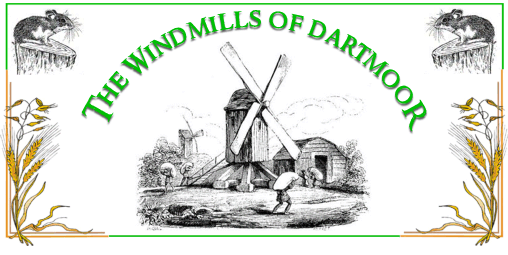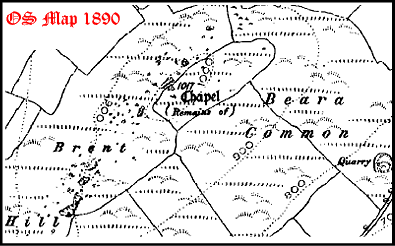
Dartmoor has an abundance of two things, water and wind both of which have been used as power sources for industry. It is ironic that at a time when wind farms are an emotive subject (due to the proposals for building one on the moor) a look back in history reveals only two dubious hints of the existence of windmills. Minchinton, in his book on the ‘Windmills of Devon’ notes that in the whole of Devonshire there were a possible 56 Windmills, 13 Tidemills, and over 600 Watermills. In the opinion of the topographical writer, Celia Fiennes, there were no windmills in Devon during the 17th century.
As previously mentioned both of the possible Dartmoor windmills are but vague references and oral tradition. The first was said to have been located on Brent Hill and Hoskins stated that there were ruins of a windmill on the hill which dated from 1790. The old OS map of 1890 shows that there are remains of a ruined chapel which clearly is not a windmill. However, one of the Buckfast monks produced evidence to show that the structure is the remains of a medieval chapel known as St. Michael’s which was built around 1374.

So how could such confusion arise? Simple, in 1790 a surgeon living in Ashburton called Nicholas Tripe built himself a new house at the top of East Street (now The Golden Lion). From his bedroom window he could see the top of Brent Hill and thought it would be nice if when he awoke in the mornings he could see a windmill. Therefore he paid for a windmill to be built on the hill which it seems simply involved fixing sails to the ruins of the medieval chapel. Sadly this means that although the first of Dartmoor’s windmills did exist it was never a properly functioning mill and was in effect simply a folly.
One down, one to go. The second possible windmill was located near the village of Shaugh Prior and its existence is down to documentary and place-name evidence. In 1561 a deal was struck between Anthony Honeychurch of Modbury and John Spark of Plympton. It involved the sale of some land called Wyndmylles and Torparke at Plympton Marie, the important name being Torparke. The tithe apportionment lists ‘Little Tor Park’ and Higher Tor Park’ at Shaugh Prior which as Minchinton suggests could refer to the Torparke of 1561. William Crossing, p426, notes that what is now called Huxton Corner was at once time known as Windmill Hill. In which case if the two ‘Tor Parks’ of the apportionment refer to the onetime Torparke of 1561 it could be concluded that the ‘Wyndmylles’ were located at Windmill Hill or as it is now called – Huxton Corner.
So there it is, Dartmoor the land of winds but no mills. There are two possibilities, firstly that there was very little grain produced therefore there was no need for windmills which if you look at the corn production is simply not true. The second option could simply be that with the amount of water power available it was easier to build mills powered by such sources which meant they could be located closer to the towns and villages.
Reading List.
Crossing, W. 1990 Crossing’s Guide to Dartmoor, Peninsula Press, Newton Abbot.
Hoskins, W. G. 1954 Devon, Collins Pub., London.
Minchinton, W. 1977 Windmills of Devon, Exeter Industrial Archaeology Group, Exeter
 Legendary Dartmoor The many aspects past and present of Dartmoor
Legendary Dartmoor The many aspects past and present of Dartmoor
